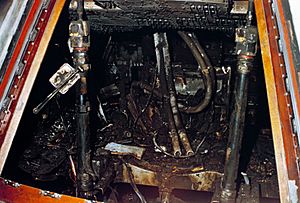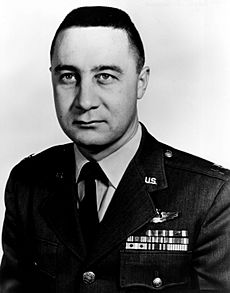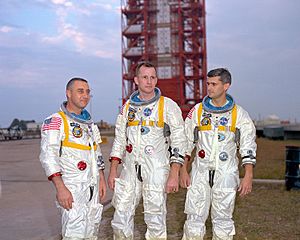Gus Grissom facts for kids
Quick facts for kids
Gus Grissom
|
|
|---|---|

Grissom in 1964
|
|
| Born |
Virgil Ivan Grissom
April 3, 1926 Mitchell, Indiana, U.S.
|
| Died | January 27, 1967 (aged 40) Cape Kennedy, Florida, U.S.
|
| Resting place | Arlington National Cemetery |
| Alma mater |
|
| Occupation |
|
| Awards |
|
| Space career | |
| NASA astronaut | |
| Rank | Lieutenant colonel, United States Air Force |
|
Time in space
|
5h 7m |
| Selection | 1959 NASA Group 1 |
| Missions |
|
|
Mission insignia
|
 |
Virgil Ivan "Gus" Grissom (born April 3, 1926 – died January 27, 1967) was an American engineer and pilot. He was one of the first astronauts chosen by NASA for Project Mercury. Gus Grissom was the second American to fly into space in 1961. He was also the second American to fly into space twice.
Grissom was a veteran of World War II and the Korean War. He was also a test pilot for the United States Air Force. He received several important awards for his service. These included the Distinguished Flying Cross and the Congressional Space Medal of Honor.
During World War II, Grissom joined the U.S. Army Air Forces. After the war, he went to Purdue University. He earned a degree in mechanical engineering in 1950. He then rejoined the U.S. Air Force and became a pilot. He flew 100 combat missions during the Korean War. After the war, he became a flight instructor. He also trained to be a test pilot.
Grissom was chosen as one of the first seven American astronauts, known as the Mercury Seven. He piloted the second American suborbital flight, Liberty Bell 7, on July 21, 1961. After landing, the capsule's hatch opened too early. This caused the spacecraft to sink. His next flight was for Project Gemini in 1965. He was the command pilot for Gemini 3, which orbited Earth three times. Grissom later became commander of the Apollo 1 mission. He died with his fellow astronauts Ed White and Roger B. Chaffee on January 27, 1967. This happened during a test for the Apollo 1 mission.
Contents
Gus Grissom's Early Life and Education
Virgil Ivan Grissom was born in Mitchell, Indiana, on April 3, 1926. His father worked for the railroad, and his mother was a homemaker. Gus was the second of four children. He became interested in flying at a young age. He enjoyed building model airplanes. His nickname "Gus" came from a friend who misread his name on a scorecard.
As a child, Grissom was a member of the Boy Scouts of America. He earned the rank of Star Scout. He said the Scouts taught him to love hunting and fishing. He also worked several jobs, like delivering newspapers and working in stores.
Grissom went to Mitchell High School. He was good at math but was an average student in other subjects. He graduated from high school in 1944. He also spent time at a local airport. There, a lawyer who owned a small plane taught him the basics of flying.
Marriage and Family Life
Grissom met his future wife, Betty Lavonne Moore, in high school. They both enjoyed school activities. They started dating and went to many movies. Grissom even taught Betty how to drive.
Grissom and Betty married on July 6, 1945, during World War II. They had two sons, Scott (born in 1950) and Mark (born in 1953). Both of their sons later worked in aviation.
Grissom loved being home with his family. He made sure work problems did not affect his family time. He would do paperwork after his sons were asleep. Betty helped by doing chores during the week. This made weekends free for family fun. Gus enjoyed hunting and fishing with his sons. The family also liked water sports and skiing.
Military Service and Pilot Training
Grissom joined the U.S. Army Air Forces in 1944. He wanted to become a pilot. He completed basic flight training in Texas. However, he spent most of his time as a clerk before he was discharged in 1945.
After the war, Grissom returned home. He worked at a bus manufacturing company. He then decided to go to college. He used the G.I. Bill to help pay for his schooling. He enrolled at Purdue University in 1946. He worked part-time as a cook. His wife, Betty, worked the night shift to help pay for their expenses. Grissom graduated with a degree in mechanical engineering in 1950.
Korean War Service
After college, Grissom rejoined the military. This time, he joined the new United States Air Force. He completed pilot training and became a second lieutenant in 1951. His family joined him briefly in Arizona.
In 1952, Grissom's squadron was sent to the Korean War. He flew 100 combat missions in an F-86 Sabre jet. He often broke up air raids from North Korean MiG planes. He was promoted to first lieutenant. He also received the Distinguished Flying Cross and the Air Medal.
After his missions, Grissom returned to the U.S. He became a flight instructor in Texas. During one training flight, a student pilot caused a problem. Grissom quickly took control and landed the plane safely.
In 1955, Grissom went to the Air Force Institute of Technology. He earned another degree in aeromechanics in 1956. In 1956, he also attended the U.S. Air Force Test Pilot School in California. He became a test pilot in Ohio in 1957.
Becoming a NASA Astronaut

In 1959, Grissom received a secret message. It asked him to learn about the U.S. space program. He was one of 110 test pilots invited. Grissom was very interested in the program.
He passed many tests, including physical and psychological exams. Doctors found he had hay fever. But Grissom argued that his allergies would not be a problem in space. So, he was allowed to continue.
On April 13, 1959, Grissom was officially chosen. He was one of the seven original Project Mercury astronauts. They began their training in Virginia.
Project Mercury Flight: Liberty Bell 7
On July 21, 1961, Grissom piloted the second Project Mercury flight. His spacecraft was named Liberty Bell 7. It launched from Cape Canaveral, Florida. The flight was sub-orbital and lasted about 15 minutes.
After landing in the Atlantic Ocean, something unexpected happened. The spacecraft's emergency hatch blew off. Water rushed into the capsule. Grissom quickly exited into the ocean. His spacesuit began to lose air, making it hard to stay afloat. He struggled until a helicopter rescued him. Another helicopter tried to lift Liberty Bell 7, but it was too heavy and sank.
Grissom told reporters he was "scared a good portion of the time." He said he did not cause the hatch to blow. NASA investigated but found no clear reason for the incident. They made changes to future flights to prevent it from happening again.

The Liberty Bell 7 spacecraft was found and recovered in 1999. Even then, no clear evidence explained how the hatch opened. Some ideas included a stray parachute line or static electricity.
Project Gemini Flight: Molly Brown
In 1964, Grissom was chosen to command Gemini 3. This was the first crewed Project Gemini flight. It launched on March 23, 1965. This made Grissom the first NASA astronaut to fly in space twice. He flew with John W. Young. They orbited Earth three times. The flight lasted almost 5 hours.
Grissom was the shortest of the original astronauts. He worked closely with the engineers who built the Gemini spacecraft. His fellow astronauts joked that the spacecraft was "the Gusmobile." He also helped invent a special controller for moving spacecraft in space.
Grissom jokingly named the Gemini 3 spacecraft Molly Brown. This was after a Broadway show called The Unsinkable Molly Brown. He chose the name because his Mercury capsule had sunk. NASA officials were not happy with the name. But when Grissom suggested Titanic instead, they allowed Molly Brown. After this, NASA decided not to nickname spacecraft for a while.
Apollo Program and Apollo 1
Grissom was later assigned to the Apollo program. He became commander of the first crewed mission, Apollo 1. His crewmates were Ed White and Roger B. Chaffee. They were allowed to call their mission "Apollo 1."
Grissom was very open about problems with the Apollo spacecraft. He was nicknamed "Gruff Gus" because he spoke his mind. The training simulator had many issues. Astronauts knew the spacecraft was not as good as it should be.
Just before a test on January 27, 1967, Grissom took a lemon from his backyard. He joked he would hang it on the spacecraft. He actually hung it on the simulator.
Death and Legacy

On January 27, 1967, a fire broke out inside the Apollo 1 Command Module. This happened during a pre-launch test on Launch Pad 34. Grissom, White, and Chaffee were inside. They died from breathing in smoke. Just before the fire, Grissom had said, "How are we going to get to the Moon if we can't talk between two or three buildings?" Then he shouted "Fire!"
The fire was caused by damaged wiring. Many other issues contributed to the tragedy. These included a pure oxygen atmosphere, flammable materials, and a hatch that was hard to open.
Grissom's funeral was held on January 31, 1967. He was buried at Arlington National Cemetery in Virginia, next to Roger Chaffee.
After the accident, NASA made many safety improvements. The Apollo program continued and successfully landed men on the Moon in 1969. Many people believe Grissom would have been chosen to walk on the Moon if he had lived.
Awards and Honors
Grissom received many awards for his bravery and service.
- Distinguished Flying Cross
- Air Medal with one cluster
- Army Good Conduct Medal
- Congressional Space Medal of Honor (awarded after his death)
- NASA Distinguished Service Medal with one star
- NASA Exceptional Service Medal
- American Campaign Medal
- World War II Victory Medal
- National Defense Service Medal with one star
- Korean Service Medal with two stars
- Air Force Longevity Service Award with three bronze oak leaves
- United Nations Korea Medal
- Korean War Service Medal
- John J. Montgomery Award
Many places and things have been named in Grissom's honor.
- A library in Newport News, Virginia.
- The airport in Bedford, Indiana, was renamed Virgil I. Grissom Municipal Airport in 1965.
- Virgil Grissom Elementary School in New Jersey was named for him before his death.
- He was given an honorary doctorate degree from Florida Institute of Technology in 1962.
- He was inducted into the International Space Hall of Fame in 1981.
- He was inducted into the National Aviation Hall of Fame in 1987.
- He was inducted into the U.S. Astronaut Hall of Fame in 1990.
Memorials to Gus Grissom


The launch pad where the Apollo 1 fire happened, Launch Pad 34, has two plaques honoring the crew. The Apollo/Saturn V Center has an exhibit for the Apollo 1 crew. Grissom's name is also on a plaque left on the Moon with the Fallen Astronaut statue.
A 44-foot tall monument for Grissom was built in Mitchell, Indiana, in 1981. The Virgil I. Grissom Memorial in Spring Mill State Park, near his hometown, was dedicated in 1971. A horse race in Indiana is named the Gus Grissom Stakes.
Grissom Island, an artificial island in California, was created in 1966. Virgil "Gus" Grissom Park opened in California in 1971. Grissom's name is on the Space Mirror Memorial, dedicated in 1991.
The star Gamma Cassiopeiae is sometimes called Navi (Ivan spelled backward). Grissom used this name, along with names for White and Chaffee, on his Apollo 1 star charts as a joke. Other astronauts kept using the names as a memorial. Grissom crater on the Moon is named after him. 2161 Grissom is an asteroid named for him. Grissom Hill on Mars was named by NASA in 2004.
Grissom Air Reserve Base in Indiana was renamed in his honor in 1968. The United States Air Force Academy Class of 2007 chose Grissom as their "Class Exemplar."
The Virgil I. Grissom Museum opened in 1971 in Mitchell, Indiana. His boyhood home in Mitchell is on Grissom Avenue.
Schools Named After Grissom
Many schools across the United States are named after Gus Grissom:
- Grissom Hall, a residence hall at Florida Institute of Technology (1967).
- Grissom Hall, a residence hall at State University of New York at Fredonia (1967).
- Grissom Hall at Purdue University, once home to the School of Aeronautics and Astronautics (1968).
- Virgil I. Grissom Elementary School in Houston, Texas (1967).
- Virgil Grissom Elementary School in Princeton, Iowa (1967).
- Virgil I. Grissom Middle School in Mishawaka, Indiana (1968).
- School No. 7 in Rochester, New York (1968).
- Grissom Elementary School in Gary, Indiana (1969).
- Virgil I. Grissom Middle School in Sterling Heights, Michigan (1969).
- Virgil I. Grissom High School in Huntsville, Alabama (1969).
- Virgil I. Grissom Elementary School in Chicago, Illinois (1969).
- Grissom Elementary School in Tulsa, Oklahoma (1969).
- Grissom Memorial Elementary School in Muncie, Indiana (1973).
- Virgil I. Grissom Middle School in Tinley Park, Illinois (1975).
- Virgil I. "Gus" Grissom Elementary School at the former Clark Air Base, Philippines (1968).
- Virgil I. Grissom Junior High School 226 in South Ozone Park, Queens, New York City.
Gus Grissom in Film and Television
Grissom has been shown in many movies and TV shows:
- Air Cadet (1951) – a brief appearance.
- The Right Stuff (1983) – played by Fred Ward.
- Apollo 13 (1995) – played by Steve Bernie.
- From the Earth to the Moon (1998) – played by Mark Rolston.
- American Dreams (TV series) – played by Kevin McCorkle.
- That Thing You Do! (film) – played by Bryan Cranston.
- The Astronaut Wives Club (TV series) – played by Joel Johnstone.
- Hidden Figures (2016) – included in the story.
- First Man (2018) – played by Shea Whigham.
- The Right Stuff (2020) – played by Michael Trotter.
In the 1984 film Star Trek III: The Search for Spock, a starship is named USS Grissom. Other USS Grissom ships appeared in Star Trek: The Next Generation and Star Trek: Deep Space Nine. The character Gil Grissom in CSI: Crime Scene Investigation and Virgil Tracy in Thunderbirds are also named after him.
Grissom was writing a book about Project Gemini when he died.
Images for kids
See also
 In Spanish: Virgil I. Grissom para niños
In Spanish: Virgil I. Grissom para niños








